demography
What Happened When We Tried to Debate Immigration
Unless we find a way of side-stepping the extremes and debating these issues in an evidence-led, analytical way then the moderate.
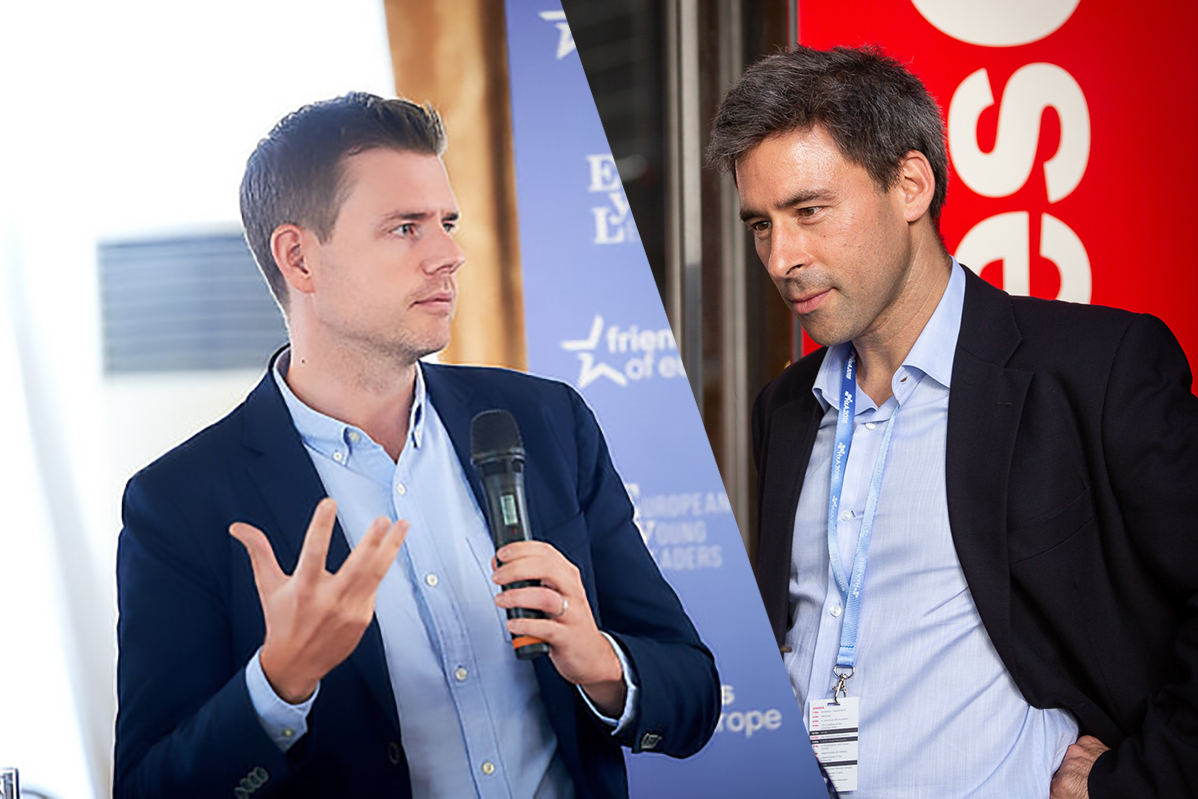
Immigration and diversity politics dominate our political and public debates. Disagreements about these issues lie behind the rise of populist politics on the left and the right, as well as the growing polarization of our societies more widely. Unless we find a way of side-stepping the extremes and debating these issues in an evidence-led, analytical way then the moderate, pluralistic middle will buckle and give way.
This is why, as two university professors who work on these issues, we decided to help organize and join a public debate about immigration and ethnic change. The debate, held in London on December 6, was a great success, featuring a nuanced and evidence-based discussion attended by 400 people. It was initially titled, “Is Rising Ethnic Diversity a Threat to the West?” This was certainly a provocative title, designed to draw in a large audience who might hold strong views on the topic but who would nonetheless be exposed to a moderated and evidence-led debate. Though we would later change the title, we couldn’t escape its powerful logic: On the night itself, we repeatedly returned to this phrasing because it is the clearest way of distinguishing competing positions.
Aside from ourselves, two university professors who between us have researched the issue for decades, the panel included Trevor Philips, the former Head of the Equality and Human Rights Commission (who is of African-Caribbean heritage), and David Aaronovitch, a liberal columnist at The Times. The debate was chaired by Claire Fox and co-sponsored by the Academy of Ideas, founded to provide a “forum committed to open and robust public debate in which ideas can be interrogated,” and the online magazine UnHerd, which aims to draw attention to stories and ideas that do not usually get covered in the mainstream media.
As soon as the title of the event was published it provoked a strong backlash. Rather than a genuine debate, it was interpreted as an open attack on immigrants and minorities. Before the event had taken place, before a word had been spoken, one professor accused us of “helping to advance a white nationalist agenda” and engaging in “nativist and racist discourse.” Other academics retweeted accounts that suggested we were “complicit in violence,” including the U.S. mail bombs and the mass shooting at a Pittsburgh synagogue (two of our panelists are of Jewish heritage). Still others contended that we were contributing to racism, that by posing the question we were “devaluing” scholars from minority backgrounds (Kaufmann is of mixed race).
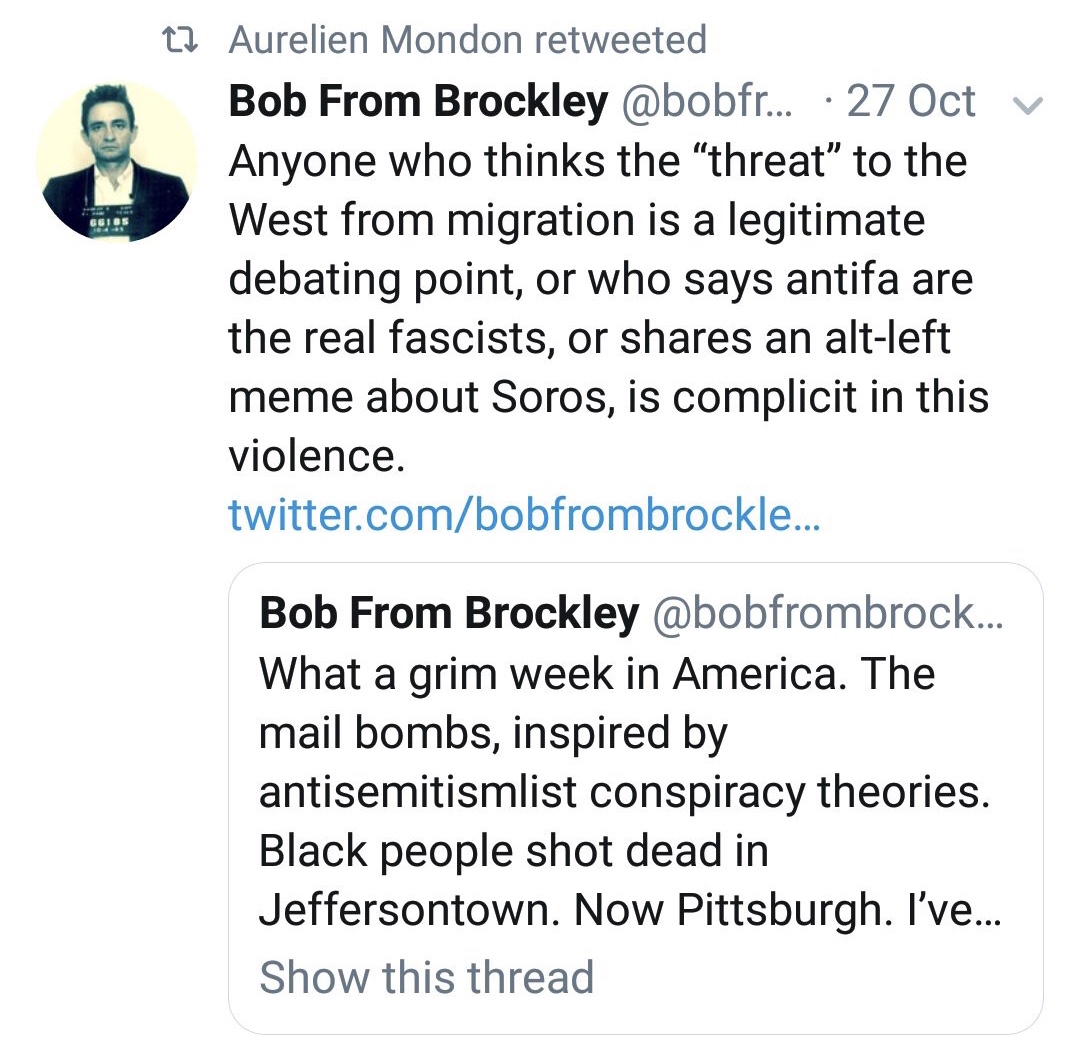
In the spirit of compromise, and to meet our critics halfway, we changed the title of the event to: “Immigration and Diversity Politics: A Challenge to Liberal Democracy?” But that was not enough. Even after this change, academics joined with self-described anti-fascist activists to publish an open letter on the platform Open Democracy. Titled “Framing ethnic diversity as a ‘threat’ will normalise far-right hate,” the letter claimed that the debate “was framed within the terms of white supremacist discourse” and “automatically targets communities already suffering from discrimination as part of the ‘problem.’” While the letter did not call for the debate to be cancelled, it concluded that “no other alternative factor or scenario is identified as a ‘threat.’” that the event had “racist presumptions,” “contributes to far right ‘dog whistling,’” and “serves to normalise ideas that should be firmly challenged.” These claims, they continued, were “undeniable.”
An e-mail account was launched and others were urged to sign the open letter, which was also shared on Twitter by a prominent (Routledge) academic book series as “an important response from anti-racist & anti-fascist academics to recent efforts to mainstream far right ideas & discourse.” One of our Wikipedia pages was vandalized while others sought to interest the press in a smear campaign. A network of activist academics and students—both inside and outside of our institutions—raised complaints with our universities. While we were not formally asked to cancel the debate, one of us came under pressure to withdraw. Like many such incidents, much of this activity was informal, relying on trolling, reputational damage and peer pressure to police virtue.
By contrast, we faced criticism from liberal commentators outside of academe who, writing in national newspapers, criticized our decision to change the title as obfuscating a pressing subject that urgently requires rational discussion. One argued that the backlash and decision to moderate the title of the debate would only embolden far-right extremists. “Ironically and tragically,” argued columnist David Aaronovitch, who joined the debate, “this idiocy by the liberal left allows the far-right to pose as the champions of free speech and therefore as champions of true British aspirations.” Jonathan Freedland of the Guardian also cautioned that “the struggle against normalization is not quite as clear-cut as some of its most righteous warriors would have you believe,” and argued that while liberal democracy may have to give space to ideas that are circulated on the far-right it must ensure that these ideas are interrogated (as was the point of our debate).
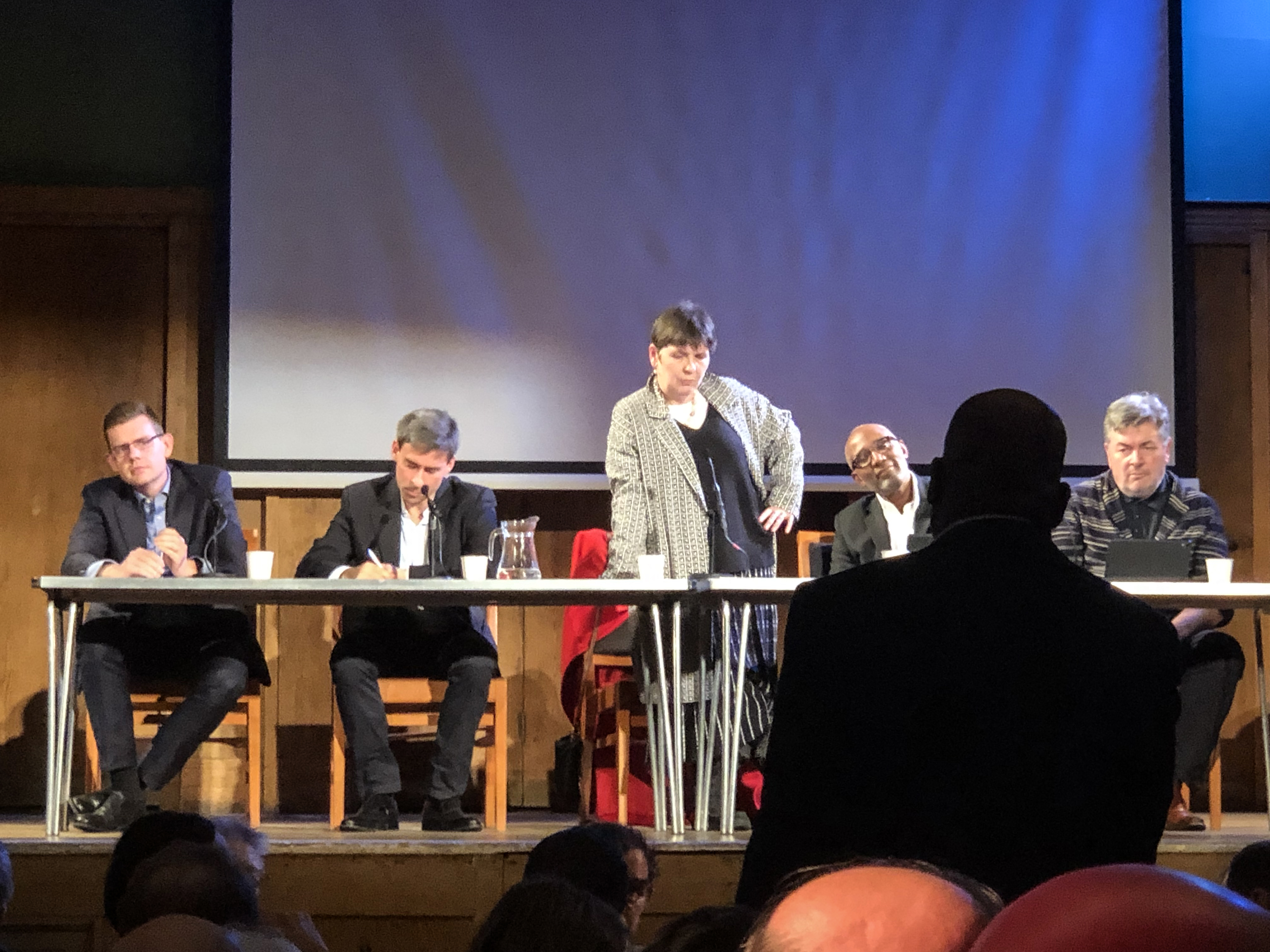
Before turning to the troublesome idea of “normalization,” we would make two points about the title. The first is that, in the world of academic research, the word “threat,” which many of our critics found so troubling, is commonplace. Stick the words “threat” and “immigration” into Google Scholar and you will see more than one million entries. “Integrated Threat Theory,” for example, has long been used to explain why some people feel more hostile than others toward immigrants and minorities, with feelings of threat, actual or perceived, being a key predictor of this reaction. Many people on social media found the idea that ethnic diversity could be seen as a “threat” extremely troubling, but Integrated Threat Theory has been used to explain, for example, how Americans and Mexicans think about each other, why Dutch adolescents voice prejudice toward Muslims, why workers feel hostile toward immigrant workers, why there are varying levels of trust in more ethnically diverse neighborhoods and why some Europeans back restrictive immigration policies. This is why some academics have openly debated, in top journals, questions like “Is Hispanic immigration a threat to American identity?”
Furthermore, the reason that academics have spent so much time exploring the idea of “threat” is because large numbers of people across Western democracies do feel under threat from immigration and rising ethnic diversity. There is no point shying away from it. It is reflected in countless studies and surveys, such as an Ipsos-MORI study last year, which found that across 25 countries an average of 42 percent of people believe that immigration is having negative effects on their country, while just under half feel that immigration “is causing their country to change in ways that they do not like.”
Another study, by the anti-racist group Hope Not Hate, an organizer of which signed the open letter against us, found that four in ten people in Britain feel that “British culture is undermined by multiculturalism” (the group subsequently called for a “national conversation about immigration that would give people a chance to express their concerns so that anxieties are not driven underground or exploited by those seeking to stoke division”—a goal that we would strongly support).
But there is also a deeper issue here, which concerns the “normalization hypothesis.” Warning against the “normalization” of the far-right has long been a cornerstone of thinking among anti-fascist and left-wing activists. The argument is that mainstream institutions like universities, the media and political parties should never give a platform to fascist or far-right figures because this treats them as legitimate actors, risks increasing their appeal, and fuels hostility towards immigrants and minorities. Merely adopting the language or phraseology of these controversial figures, it is argued, even as a basis for a public debate or critical reflection, lends credence to their ideology.
The “normalization hypothesis” is widely accepted by journalists and academics, including those who work on populism, fascism and closely-related fields like immigration, identity, criminology, race and gender. Witness the tweet by the academic book series on Fascism and the Far Right that presents Anti-Fascist Action’s (AFA) no-platforming for fascists as “a good baseline for praxis.” Those who do not adopt this line are criticized, often with support from left-wing journalists.
1) No platform for fascists
— Anti-Fascism & Far Right 🥤 (@FFRAFAction) October 28, 2018
2) Fascism must be opposed ideologically
3) Fascism must be opposed physically
These were 3 main principles of UK group, Anti-Fascist Action (AFA)
While ‘platforms’ in digital era are a more nebulous concept, this is still a good baseline for praxis
Setting aside the fact that we are not members of the “far-right,” normalization is a perfectly reasonable hypothesis where genuine far-right speakers are concerned. But, like all theories, it must be open to falsification. It should only gain strength after surviving repeated attempts at refutation. Once a theory congeals into what the anthropologist Scott Atran has called a “sacred value,” something that lies beyond question (such as the divinity of Jesus for Christians), it stifles the progress of social science and restricts freedom of enquiry. Or, even worse, it can backfire, abetting the very forces it opposes. Given the importance of free expression and inquiry in any open society, we believe it is incumbent upon those who demand an ethical limit on free expression in the interests of sensitivity to offer rigorous evidence of harm, and a method of demonstrating harm that is transparent and can be replicated and falsified.
The claim that our title was deeply offensive to ethnic minorities and risked fueling xenophobia by “mainstreaming” far-right discourse should be put under the microscope. Researchers must always be willing to open their claims to measurement and back assertions up with data. All of us are prone to confirmation bias and motivated reasoning. The whole point of science is to define terms and hypothesized relationships, set out ways to measure these, and then test them as rigorously as we can–without making claims that go beyond what the data support. This can be done quantitatively or qualitatively (via a critical mass of scholars, so long as they have viewpoint diversity). To turn our backs on the scientific method is to yield to our biases, abandon the quest for objectivity and simply engage in a naked struggle for power.
So, let’s interrogate this idea of normalization. The first thing to say is that there are actually some good reasons to be skeptical about the claim that engaging with controversial ideas, even far-right ideas, or even giving controversial speakers a platform, has an effect on public opinion. Recently, voting results before and after the involvement of Steve Bannon at the Toronto Munk debate suggested that his appearance had zero effect on people’s views. In Britain, the appearance of a right-wing extremist leader on a popular television show in 2009 had no statistically significant increase in support for his party (which one year later promptly collapsed). While there are plenty of studies that show priming or framing effects (i.e. people who read a negative passage about immigration become more concerned about it), the idea that exposing a controversial speaker to critical questioning, or using a controversial phrase to frame discussion on a “mainstream” platform somehow increases support for extremism, has no basis in social science. The “normalization” charge is an article of faith rather than a conclusion based on an empirically-verified theory. The fact that it is so often invoked to no-platform speakers on university campuses, or silence enquiry, means that it must be held to empirical account. We believe in free inquiry, but we also understand there are societal considerations to weigh in the balance. So if there are demonstrable harms that are large enough to offset the good that comes from open debate using controversial terminology, we need to take this extremely seriously.
Our critics, including those who signed the open letter, put forward two claims. First, that our debate was deeply offensive to immigrants and ethnic minorities. Second, that the “white supremacist framing” “normalized” public hostility toward these minority groups. Let’s interrogate the first claim, that deep offense has been given. To answer this question, within a modest budget, we conducted surveys of people in Britain and America, using the online platforms Amazon Mechanical Turk and Prolific Academic. These have been used by thousands of academic papers. Those who take these surveys skew more liberal, young and white than average–this is not a random sample of the population. But when comparing groups (whites versus minorities, liberals versus conservatives) they provide tests of significant relationships in the data. Our sample is 500 respondents across four surveys.
We first tried to ascertain whether minorities were offended by the original title of our debate. We split a sample of 190 Britons and 56 Americans into three groups. One group saw our original title (“Is Rising Ethnic Diversity a Threat to the West”), another saw a picture of John Esposito’s (1993) book The Islamic Threat: Myth or Reality, and a control group saw a blank page. Note that the cover to Esposito’s book included, at the top, a New York Times endorsement saying it was “a useful antidote to the barrage of exaggerated views on Islam.” The sample was evenly split between white and minority respondents. People were then asked: “On a scale from 0 to 100, where 0 is ‘not at all’ and 100 is ‘very much’, how interested are you in the above?” We wish that the 47/100 average score for our debate had been higher but we’ll take it. Respondents were then asked: “How offended are you by the above?” using the same phraseology. Earlier in the survey we had also collected information about our respondents, such as their age, gender, education, liberal-conservative ideology, attitude toward Brexit, and which party they had voted for at the most recent election.
What did we find? First of all, the average level of offence among those who read our (original) debate advertisement was very low, at just 28 out of 100. This was, however, slightly higher than for the blank page (11/100) and the picture of John Esposito’s book (18/100). Indeed, there were a few individuals who gave our ad a 100 score, demonstrating maximum offence. But who were they? If we focus on the 79 individuals (41 white and 38 non-white) who were shown the debate poster, we find no significant difference in the degree to which whites and minorities find it offensive. However, the one group that was most offended (giving a score above 50 on the “offensiveness scale”), were those who self-identified as “extremely liberal” on a seven-point liberal-to-conservative scale. In other words, it was extreme liberals who were the most likely to be highly offended by the initial title of our debate.
Figure 1 shows the results, broken down by race and ideology. While the error bars for race overlap, showing no statistically-significant effect, ideology exhibits an important “non-linear” relationship, with “extreme liberals” standing clearly apart from moderate liberals and conservatives. It seems that whether someone was offended by our debate had to do with ideology, not race.
Whether or not you felt offended by our debate is anchored strongly in social construction: Those who feel the most strongly invested in liberal ideology, regardless of race, found the description about our debate more offensive than others.
Figure 1: Degree of Offense by Race and Ideology
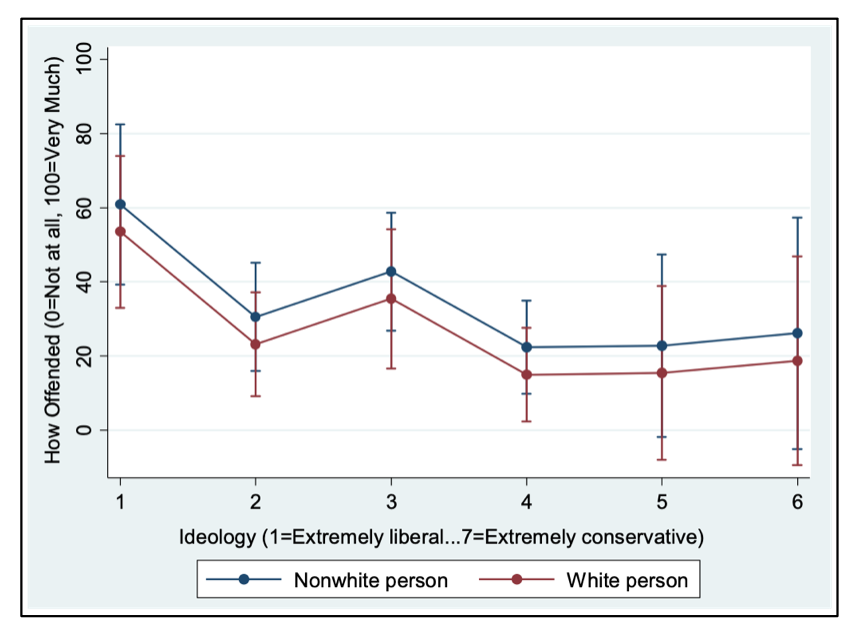
N=80 (41 white, 39 non-white). R2=.18. Controls for age, education, gender, U.K./U.S. (all not significant, thus dropped). “Extreme liberal” is significant at p<.01 level. Note that we have no “extremely conservative” (scale point 7) respondents in this sample. Platform: Prolific Academic.
What about the second charge, that we are “normalizing” racist discourse? If this was indeed the case, we would expect whites who were shown the description of our debate to alter their perception of ethnic minorities–to become more hostile. But the 41 whites who were shown details of our debate did not express any less warmth on a 0-100 thermometer scale towards Muslims, Asian and African immigrants, black people or European immigrants than the group of 33 whites who viewed a blank page, or the 51 that saw Esposito’s book cover. Like those who viewed the Munk debate, the effect on “hate” is again nil. These results are consistent with representative U.S. surveys showing that largely white “solid liberals” (16 percent of people) or “progressive activists” (eight percent of people) are much more radical than the political tribes occupied by most minority voters.
We academics—and those in discursive bubbles more generally—can sometimes possess a fine-tuned sensitivity, and a greater sense of our own importance, which others do not share. This holds as much for offenses against the right, as those against the left. Take the case of one of those who signed the open letter against us, the “radical political theorist” George Cicarellio-Maher. On Christmas Eve 2016, Cicarellio-Maher tweeted “All I want for Christmas is White Genocide.” “White genocide” is an anti-Semitic conspiracy theory that has gained currency among far-right groups. Numerous right-wing trolls and callers besieged Cicarellio-Maher with threats, including death threats. He eventually had to leave his position at Drexel University, a lamentable victory for the mob over academic freedom. We decided to re-run our analysis, only this time we showed respondents the tweet by Cicarellio-Maher. In sharp contrast to the description of our debate, of the 130 respondents who saw the tweet (65 each in UK and US), most were offended, though not overly so. The average score across the US and UK was 59/100 (versus an average score of 28 for our debate). British respondents were more offended (66/100 compared to 52/100 in the U.S.). But, as with our debate, there was no significant difference between whites and ethnic minorities. Rather, the gap was between liberals and conservatives, and Clinton and Trump supporters. This time, the “extreme conservatives” stand out for scoring the tweet 100/100 for offensiveness.
Figure 2: Reactions to “White Genocide Tweet” by Race and Ideology
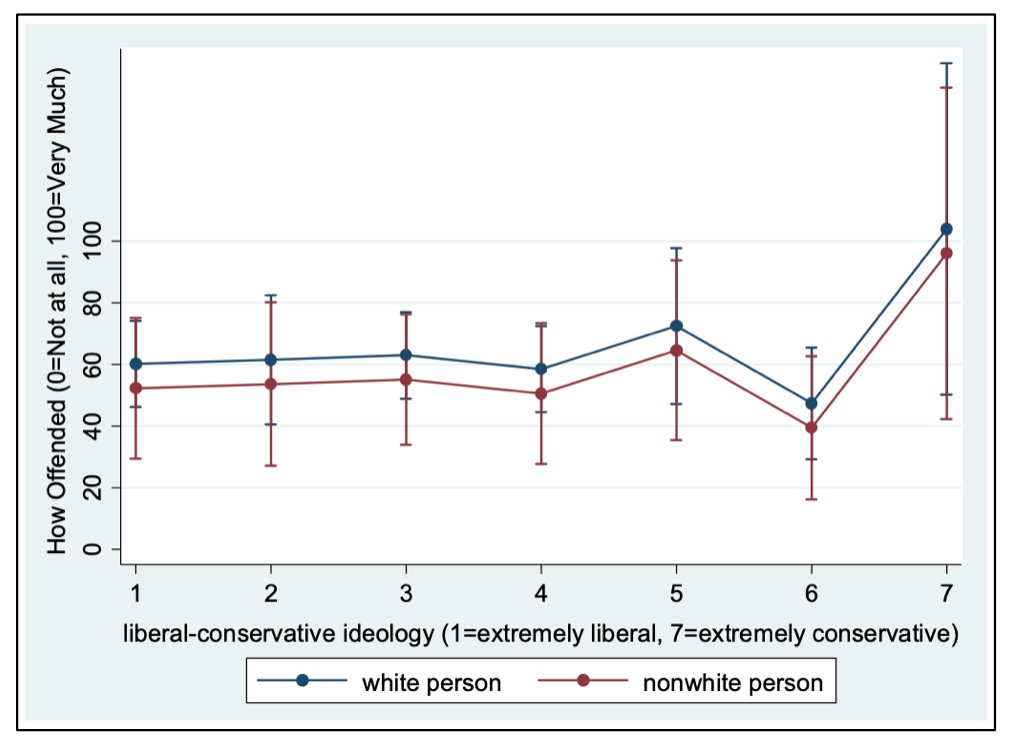
N=130 (65 UK, 65 U.S., 112 white, 18 non-white). R2=.08. Controls for age, education, gender, U.K./U.S. (all not significant apart from U.K. resident, retained in model). “Extremely conservative” is borderline significant at p<.05 level. Platform: Prolific Academic (U.K.) and Amazon MTurk (U.S.).
Moreover, white respondents who read Cicarellio-Maher’s “white genocide” tweet did not become more hostile toward minorities and immigrants. If anything, whites who were exposed to his tweet became warmer towards African and Asian immigrants (though no effects were visible for other minorities). They were offended by the tweet but this appeared to make some people more sympathetic to minorities. Why does this matter? Well, it goes to show that people aren’t the impressionable pieces of clay which the proponents of “normalization” would have us believe. While ideas have consequences, those consequences are complex and they often refuse to cooperate with simplistic narratives that enjoy support among activist scholars but which, when put under the microscope by evidence-led researchers, fall apart. Unlike our critics, we don’t invoke ethereal concepts like “normalization” or sacred narratives; our methods are transparent and open to replication and falsification (we will happily share these data).
Clearly, this doesn’t exhaust the range of tests that might be conducted. It would be important to look at the content of far-right posts and videos following our debate to see if the title predicts increased far-right activity or support, as we should for Cicarellio-Maher’s tweet. While we doubt that our event aroused much interest in far-right arenas, it is more likely that the “white genocide” furore attracted debate on prominent ultra-right-wing blogs (such as Stormfront). There is also compelling evidence from large-scale survey data that whites’ perceptions that they are being discriminated against is a driver of Trump support and this kind of tweet may have fed those perceptions (due to a sense there is a double-standard in which only white people may be abused, especially among “cultural elites”). Yet a closer relationship between the content of the “white genocide” tweet and whites’ perceptions of being discriminated against would need to be established before making a strong claim that Cicarellio-Maher gave national populism a shot in the arm. We also think that anyone seeking to link the “white genocide” tweet to violence or increased far-right recruitment would need to do more than assert the case, as our interlocutors have with our debate.
But, even then, effects would need to be substantial to provide sufficient grounds for censuring debate in a free society. After all, discussion of controversial topics like Britain’s Middle East policy or Israeli settlements can give ammunition to Islamist extremists. This does not mean that these subjects should not be discussed in plain language and in a moderate, reasonable way. Moving forward with debate must be weighed against the cost of not doing so, which could involve ideas gaining popularity underground or giving ammunition to conspiracy theories against “elites.”

As the Supreme Court Justice Louis Brandeis said: “Fear of serious injury cannot alone justify suppression of free speech and assembly. Men feared witches and burnt women. It is the function of speech to free men from the bondage of irrational fears. To justify suppression of free speech, there must be reasonable ground to fear that serious evil will result if free speech is practiced.”
Short of any empirical evidence that shows harms arising as a direct result of a debate over the harms of not having a debate, we feel that free societies should engage in open discussion of uncomfortable issues. To return to Jonathan Freedland, this is exactly why our discussion was designed in a way that would allow ideas to be interrogated by a diverse panel, a moderated discussion, and questions from the public.
The reaction to our debate reflected the three psychological processes identified by Jonathan Haidt and Greg Lukianoff in their new book The Coddling of the American Mind. Haidt and Lukianoff warn that progressive activists at elite American campuses are engaging in precisely the kind of psychological processes that Cognitive Behavioral Therapy (CBT) seeks to correct. Catastrophizing involves focusing on the worst possible outcome as the most likely outcome. “If I don’t get a good grade, my life is over,” is one example. Another is the notion that a public debate will help fascists to triumph.
Haidt and Lukianoff also draw attention to the pitfalls of emotional reasoning: “Always trust your feelings” is a poor guide to the world compared to observing representative data, attempting to refute one’s intuitions with alternative explanations and only accepting theories that have withstood repeated attempts at falsification. When a topic feels uncomfortable, or sounds offensive, it is important to resist one’s gut feeling that something immoral is taking place until evidence comes in. Yet few of our critics were willing to look past this emotional reasoning.
And finally, dichotomous thinking. Collapsing the complex reality of the world into a black-and-white morality tale in which there are good and evil people (or fascists and anti-fascists) is the third “great untruth.” Populists are masters of this approach. The notion that there are “good” anti-fascists who are protecting minorities from “bad” fascists is an example of this cognitive style. Surprisingly, many academics who specialize in the study of populism have proved all too willing to exhibit dichotomous thinking.
All three modes are displayed in the open letter and in the vitriolic attacks that followed. These and other attempts were aimed at smearing our reputations. As Haidt notes, the use of open letters, which seek to close down serious deliberation, has increased dramatically from 2017: “Such letters are efforts to win by applying social pressure, magnified by social media, rather than using the proper method of the academy: Reasoned argument.”
While we are all for robust debate, the response to our event reveals a great deal about the mindset of some of our most vociferous opponents, including those who teach our young adults in universities. We only hope this brand of anti-intellectualism does not penetrate more widely within the academy, both in Britain and elsewhere.






